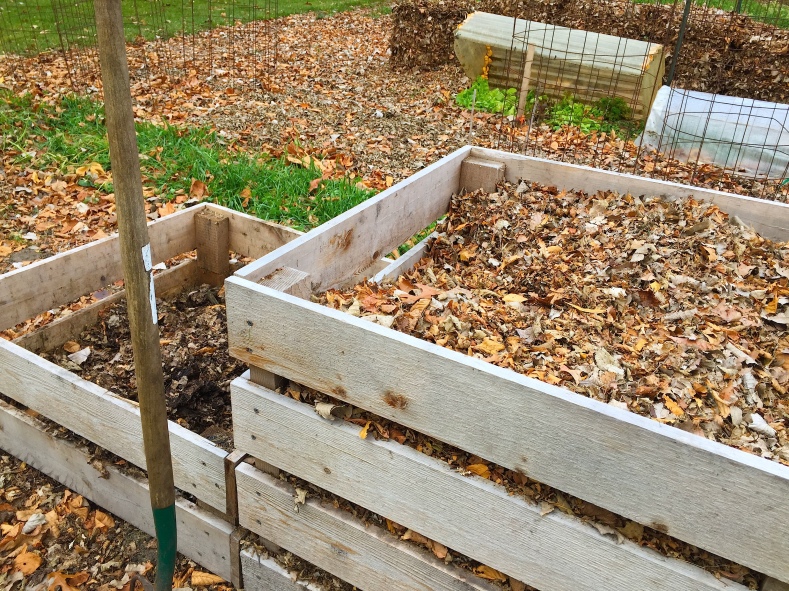I came across a study that poinked my interest immediately. Who studies this?
A chemical analysis of 100 municipal leaf samples collected from across New Jersey shows that leaves are a valuable source of all crop nutrients. Although nutrient concentration values vary considerably, the application of 20 ton/acre of leaves would add on average 400 pounds of nitrogen, 40 pounds of phosphorus, and 152 pounds of potassium.
So I thought it would be fun to ballpark what that translated to in my 750 sq. ft. of planted space (which excludes paths).
An acre is 43560 sq. ft. Divide that by my 750 sq. ft. and you get 58.2. So the actual planted area of my garden is about 1/58th of an acre (yikes, so tiny!)
The amount of leaves I’d need to put onto my garden to replicate the 20 tons/acre cited in the example would be about 700 lbs.
I don’t weigh the leaves I collect. Absolute negligence.
But 700 lbs. doesn’t seem out of the realm of possibility at all. Those tarp-loads are heavy, and I couldn’t even begin to guess how many loads I collected, let alone their weight.
I believe it was many more than 700 pounds, but let’s use 700 for convenience. That would translate to almost 7 lbs. of nitrogen, 2/3 lb. of phosphorus and 2 1/2 lbs. of potassium. Nice.
But (isn’t there always a but?) all that goodness isn’t like plopping down a bucketload of nitrogen or potassium:
The abundant carbon content of leaves leads to extensive development of fungi and bacteria in the soil which uses up the supply of available nitrogen for the production of microbial cell tissue. As decay proceeds, the carbon-nitrogen ratio decreases and some of the nitrogen becomes available to plants. Because of the high carbon content of raw leaves relative to their nitrogen content, there will likely be very little of the organic nitrogen in leaves available to crops for a period of time after application. Observations of crops (including legumes) planted on soil to which leaves have been applied indicate that plants suffer from a temporary N deficiency unless additional N fertilizer is added.
In human talk, you can’t just dump leaves and get a poof of nitrogen immediately useful for your plants. It takes time.
What does this mean to me? Uhhhh…
Quantifying gardening is like stapling jello. Mostly stupid, but fun. I think it means that leaves on the garden are good.
Let’s go with that.


Sam, have you heard of Back to Eden Garden? I may have asked you this already. It is a video online, and then there are a bunch of YouTube videos about the guy. He plants in wood chips. Pretty amazing stuff.
LikeLike
I have heard of and watched some. You’re right, it’s good stuff! (It’s Dan though). 🙂
LikeLike
Dan, my sincerest apologies.
LikeLiked by 1 person
Haha, no prob. I do that all the time!
LikeLike
If I had a gas powered mower, I’d run over the leaves a few times to help break them down. Every year, a trees roots reach further down into the ground and pull up new nutrients. Leaves are an excellent source for your compost bin! Go get em Dan!
LikeLiked by 1 person
Agreed James. I try to get them shredded as small as possible with the mower (keeping in mind that using the mower also costs gas). Gotta keep the worms busy too.
LikeLiked by 1 person
I still use the old fashioned push mower. It’s so peaceful and quiet, doesn’t stink and is James powered.
LikeLiked by 1 person
Interesting isn’t it? The microorganisms use nitrogen to break down the carbon which will actually drop the nitrogen level – hence mulching while fantastic can cause loss of nitrogen. I look at the forest and leaf litter and think ‘heck it works in nature’. Great blog Dan – nice to know you are good at math!!!
LikeLiked by 1 person
You’re absolutely right about the forest Julie. Not so much about my math 🙂
LikeLiked by 1 person
Thanks for reminding me that ‘leaves on the garden are good’. I have a huge sycamore tree that dumps leaves in the autumn and it is so much easier to put them in the municipal recycling than to keep them for myself – I’ll try and remember to hold on to more of them next year
LikeLiked by 1 person
Awesome!
LikeLike
I had wrote a post about how I get ready for spring planting in the fall, which includes this process. I never knew the numbers, thanks for enlightening me, but I also mulch grass clippings, cardboard and rabbit poop with the leaves. I have no doubt that rabbit droppings increase the nitrogen levels immediately. Great post.
LikeLiked by 1 person
I am thinking maybe you really need some sunlight and fresh air….winter is taking a toll my cyber friend. 🙂
LikeLiked by 1 person
You’re so right Sarhn. Well, I’d even sacrifice the sunlight for a little WARM air!
LikeLiked by 1 person
Yes warm air to defrost your plumbing!
LikeLiked by 1 person
Pingback: leave it | vegetablurb | WORLD ORGANIC NEWS
Pingback: Pottering in the rain | Reclaiming Paradise